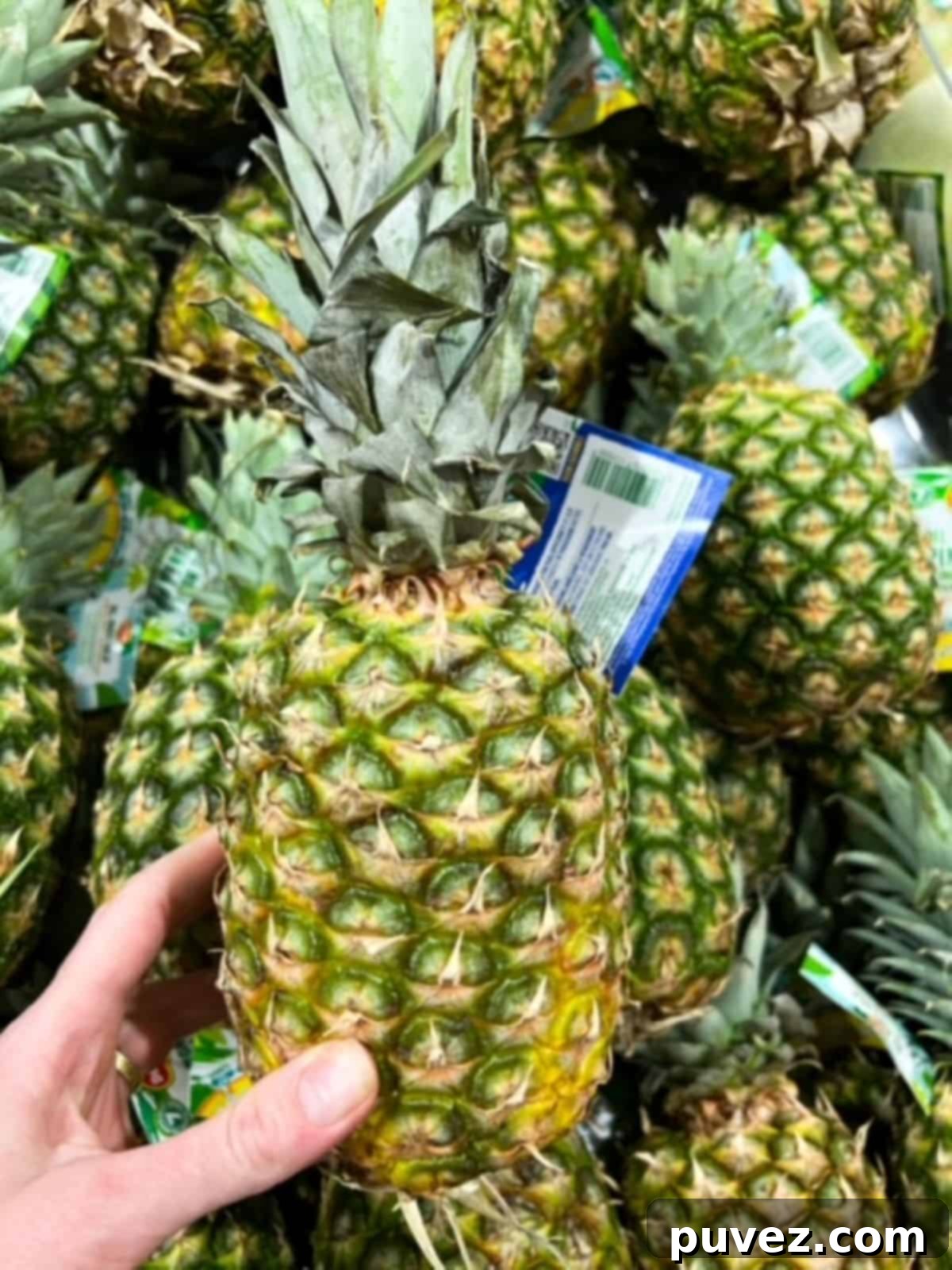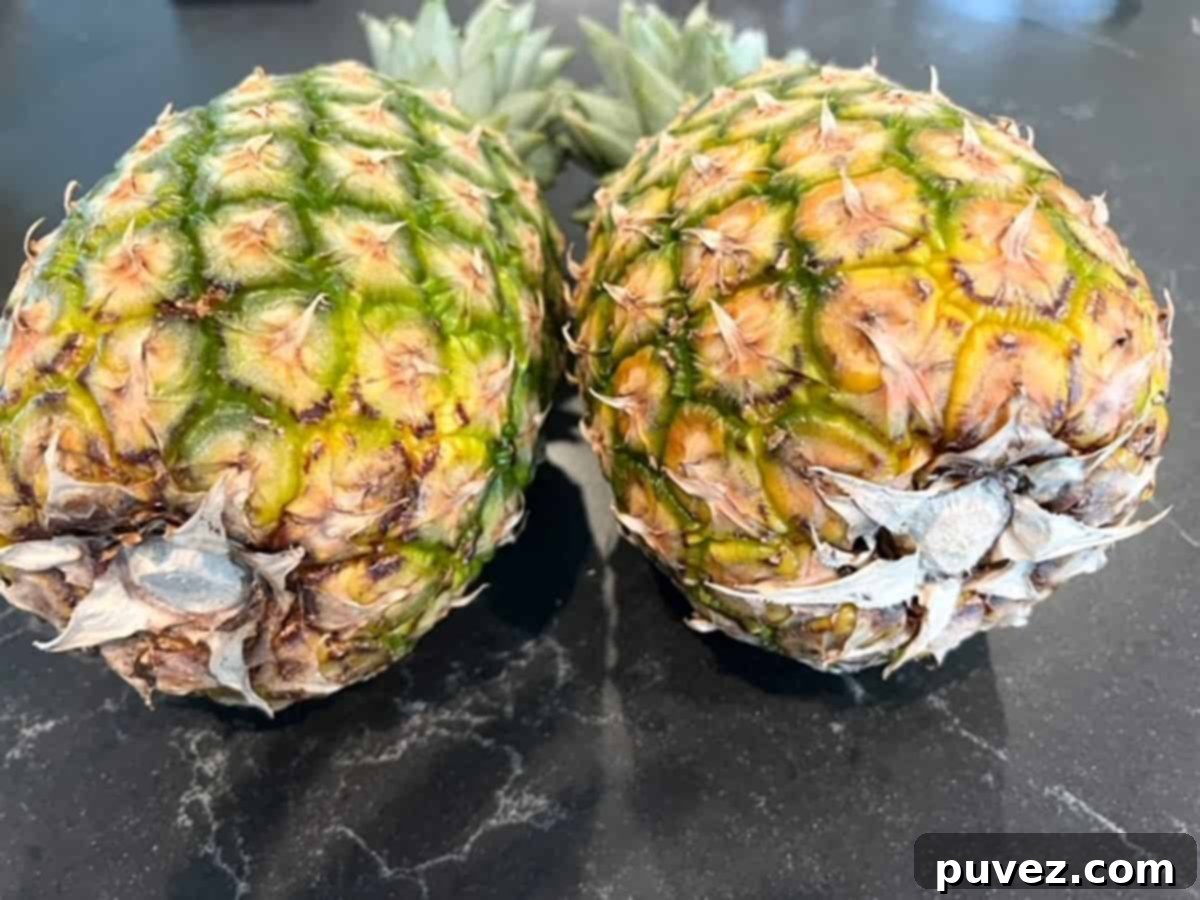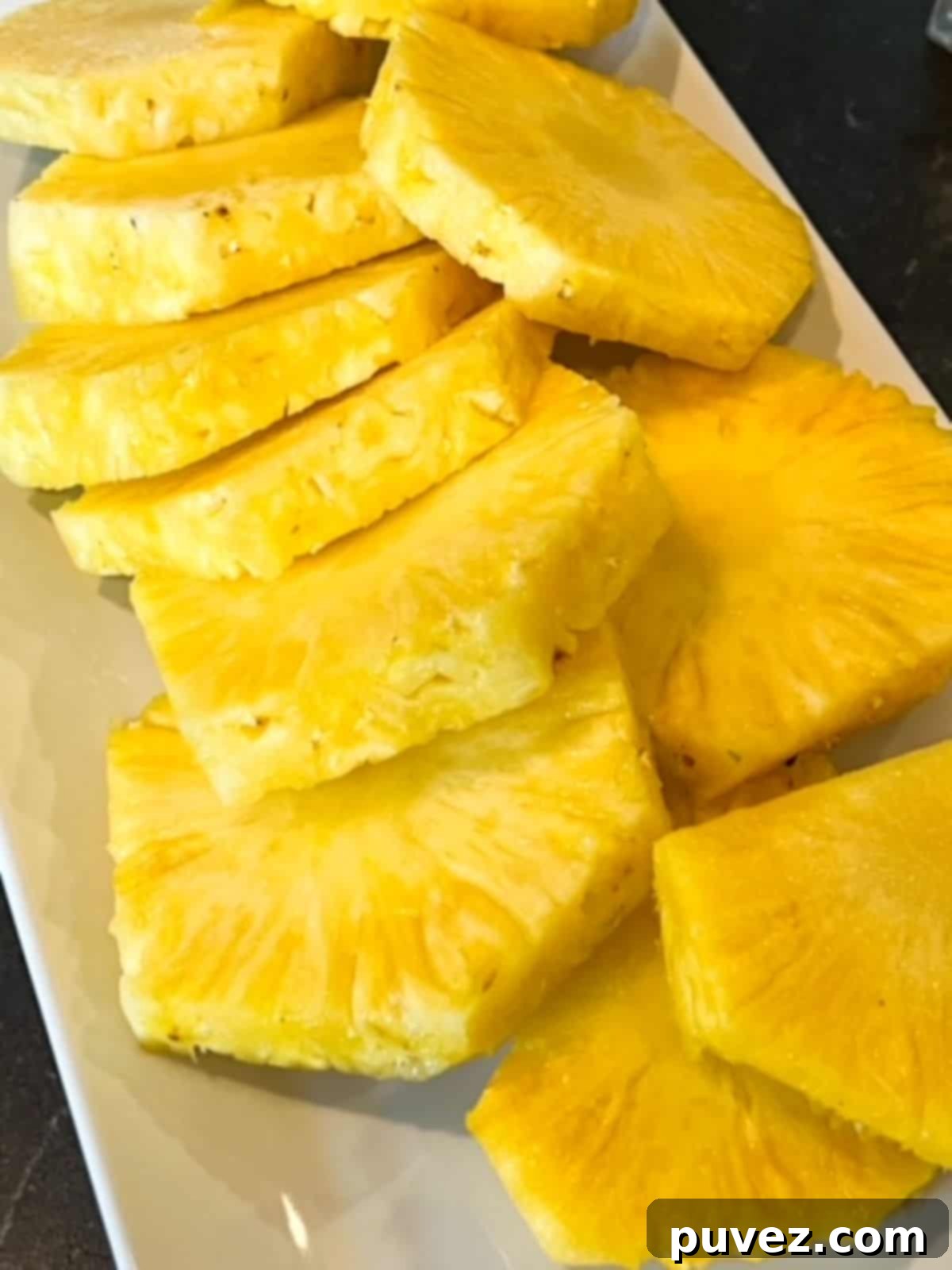How to Pick a Ripe Pineapple: Your Ultimate Guide to Sweet & Juicy Perfection
There’s nothing quite like the vibrant sweetness of a perfectly ripe pineapple. Its tropical aroma and juicy, tangy flavor can elevate any dish, from refreshing fruit salads to savory grilled creations. But how do you ensure you’re picking the best one from the grocery store display? The secret lies in understanding the subtle cues of a pineapple’s look, feel, and smell. With a few quick and easy tips, you’ll be able to confidently tell when a pineapple is ripe and know how to pick a good pineapple every single time.

After years of regularly preparing fruit salad with fresh pineapple, I’ve honed my skills and consider myself quite adept at selecting only the finest pineapples. So, when my cousin recently texted me asking for advice on picking a good pineapple, I knew it was time to share my tried-and-true methods. Just like when you’re shopping for ripe bananas, where you avoid those that are too green or too brown, it’s crucial to understand that not all pineapples at the store will be at their peak ripeness.
I know the temptation is strong: just grab what you need and get out of the grocery store. However, with pineapples, a little extra attention goes a long way. Trust me, you don’t want to just toss one in your cart and “hope for the best.” Taking a moment to pause and assess a pineapple before you commit to it is incredibly worthwhile. The good news is that discerning a good pineapple only takes about a minute once you know what to look for. It’s surprisingly easy once you get the hang of it!
What Does a Ripe Pineapple Look Like? (The Visual Cues)

1. Inspect the Base (Bottom) Color
The first place to look is the bottom of the pineapple, often called the base. A ripe pineapple should have a vibrant yellow color spreading up from its base. It’s okay if there are still some green parts, especially if they are mixing with yellow. However, if the base is primarily green, the pineapple is likely not ripe enough and will taste tart and unpleasant. Conversely, if the base is a dark yellow, burnt orange, or even reddish-brown, it’s a sign that the pineapple is overripe, potentially mushy, and might even have started to ferment.
In the image above, you can observe two pineapples. The one on the right exhibits a slightly darker yellow hue at its base compared to the one on the left. Both still had a pleasant, sweet smell, so I decided to purchase them. It turned out that the flesh of the pineapple on the right was incredibly ripe and juicy, just at its peak without being overripe. The pineapple on the left was also perfectly ripe, offering a delightful balance of sweetness and tang. This shows that a range of yellow is acceptable, as long as it’s not excessively dark or still mostly green.

2. Examine the Leaves (Crown)
Next, cast your eyes upon the crown, the bunch of tough, spiky leaves protruding from the top. The leaves of a ripe pineapple should be green and fresh-looking, not withered or brown. While a few small brown tips are generally acceptable, large brown patches, dry, brittle leaves, or any signs of mold are strong indicators that the pineapple is rotten or far too ripe to enjoy. A healthy, vibrant green crown suggests a healthy fruit.
3. Check the “Eyes” or Scales
The individual segments or “eyes” of the pineapple can also offer clues. While not as definitive as the base color, generally, the eyes should be plump and somewhat flat, not shriveled or overly concave. The overall skin should appear healthy and free from significant bruises or soft spots. A little brown around the edges of the scales is usually fine, but widespread discoloration or dark, soft spots suggest damage or spoilage.
What a Ripe Pineapple Should Smell Like (The Olfactory Test)
The aroma is perhaps the most reliable indicator of a pineapple’s ripeness. Lift the pineapple and take a good sniff at its base. A ripe pineapple should emit a distinctly sweet, fruity, and slightly tropical scent. It should smell like, well, pineapple! This pleasant fragrance is a sign that the sugars inside are fully developed and ready to be enjoyed.
However, pay close attention to the intensity of the smell. If the aroma is overpowering, strong, or has a fermented, alcoholic, or vinegary undertone, the pineapple is likely overripe. This strong smell indicates that the fruit has started to break down and will taste unpleasant. Conversely, if the base has little to no smell, it usually means the pineapple is unripe and will lack sweetness and flavor.
Here’s a tricky but important point: pineapple often doesn’t have a strong smell when it’s cold. If you pick up a pineapple that meets all the other visual and tactile criteria for ripeness but feels cold, it might not have much of a discernible scent. This doesn’t automatically mean it’s unripe. In such cases, rely more heavily on its appearance and feel. This happened to me at Aldi recently; all the pineapples were chilled, so I couldn’t properly assess their scent, but I successfully used the other methods.
What a Ripe Pineapple Feels Like (The Tactile Test)
1. The Weight and Firmness Test
When you pick up a pineapple, it should feel heavy for its size. This heaviness is an excellent indicator of how juicy and succulent the fruit is inside. A light pineapple usually means it’s dry and less flavorful. Next, gently squeeze the body of the pineapple, particularly around the base. A ripe pineapple should feel firm but have a slight “give” when gently pressed. It should not be rock-hard, which indicates it’s unripe, nor should it be mushy or soft in any areas, which points to overripeness or spoilage.
2. The Leaf Pull Test
This is a classic and often very reliable test. Gently try to pull out a single leaf from the very center of the pineapple’s crown. If the pineapple is perfectly ripe, a leaf should pull out with relative ease, requiring only a gentle tug. If you have to exert considerable force, or if the leaf resists pulling out entirely, it’s a good sign that the pineapple isn’t quite ripe enough. This tip was something I learned years ago working at a produce market in high school. While sometimes the inner leaves can be small and hard to grasp, if you can reach one, give it a try!
Dietitian Tip: Pineapple’s Nutritional Powerhouse & Versatility
Pineapples are not just delicious; they are also an incredibly nutritious and versatile fruit. They are an excellent source of Vitamin C, a powerful antioxidant that boosts immunity, and manganese, an essential mineral for bone health and metabolism. Pineapples also contain bromelain, an enzyme known for its anti-inflammatory properties and aid in digestion. Plus, they offer a good amount of dietary fiber, promoting digestive health.
I often stock up on pineapples at Aldi because they are wonderfully inexpensive, often costing around two dollars each. Their versatility in the kitchen is what truly makes them a favorite. Pineapple can add natural sweetness and tang to a wide variety of dishes:
- Blend it into a creamy mango pineapple smoothie or a refreshing green tropical smoothie.
- Dice it up and mix it with other berries for an effortless fruit salad.
- Skewer pieces of pineapple with other fruits to make fun fruit skewers.
- For a decadent treat, dip pineapple chunks in chocolate to create chocolate-covered pineapple pieces.
- For a unique flavor, try grilling pineapple slices. The heat caramelizes their natural sugars, intensifying their sweetness and adding a smoky depth perfect for a dessert or a side dish with savory meats.
Do Pineapples Ripen After Picking? The Truth Revealed
This is a common question, and there’s a lot of misinformation out there. The simple, scientific answer is: **no, pineapples do not significantly ripen after they are picked.**
Unlike climacteric fruits such as bananas or avocados, which continue to ripen and sweeten after harvest, pineapples are non-climacteric. This means they do not produce ethylene gas (the ripening hormone) once separated from the plant. While an unripe pineapple might become slightly softer and juicier after picking, its sugar content will not increase. The sweetness you taste in a pineapple is developed solely on the plant. Therefore, what you buy is what you get in terms of sweetness.
You’ll find many popular tips suggesting how to “ripen” a pineapple: storing it upside down, placing it in a brown paper bag with other ripe fruit, or even burying it in rice. While these methods might slightly soften the fruit or help redistribute existing sugars, they will not magically increase its sweetness or develop new flavors. A pineapple picked unripe will remain tart, even if it softens a bit. This is precisely why it’s so crucial to choose a truly ripe pineapple at the store using the senses we’ve discussed.
Helpful Tips for Pineapple Enjoyment
- Uneven Ripeness: The flesh at different ends of a pineapple can vary. The bottom of a pineapple is often sweeter and juicier than the top because it ripens first and contains a higher concentration of sugars due to gravity. Keep this in mind when cutting and eating, and adjust your cuts if you want to enjoy the sweetest parts immediately.
- Easy Crown Removal: The crown (bunch of pointy leaves) at the top of a pineapple is surprisingly easy to break off from the base by hand. Simply twist it firmly. This is helpful not only for preparing to cut the pineapple but also for easier storage in your refrigerator if you’re keeping a whole ripe pineapple for a couple of days before cutting it.
- Storing Whole Pineapples: If you’re not planning to cut your ripe pineapple immediately, you can store it whole at room temperature for a day or two. For slightly longer storage (up to 3-5 days), place the whole pineapple in the refrigerator. Ensure it’s not placed with strong-smelling foods, as it can absorb odors.
- Avoid Bruises and Soft Spots: Always check the entire surface of the pineapple for any signs of bruising, mold, or excessively soft spots. These indicate damage or spoilage and will affect the taste and quality of the fruit.
Frequently Asked Questions About Pineapples
The easiest way to cut a pineapple involves a few simple steps. First, cut off the top leafy crown and the bottom base. Then, stand the pineapple upright and use a sharp knife to carefully slice off the skin from top to bottom, working your way around the entire fruit. Once peeled, I typically cut the pineapple into quarters by slicing along the core lengthwise. From there, you can easily cut the delicious flesh into spears, chunks, or rings. For visual guidance and more specific instructions, check out my Fresh Fruit Salad post!
Once peeled and cut, fresh pineapple can be stored in an airtight container in the refrigerator for up to 3 to 5 days. Beyond that, it will start to lose its freshness, flavor, and texture, and may begin to ferment or go rancid.
Yes, absolutely! You can refrigerate a whole, uncut pineapple for two to three days to keep it fresh until you’re ready to slice into it. Once cut, fresh pineapple should always be refrigerated in an airtight container to maintain its quality and prevent spoilage.
Pineapple is packed with nutrients! It’s an excellent source of Vitamin C, which supports immune health, and manganese, important for bone strength. It also contains bromelain, an enzyme known for its anti-inflammatory properties and ability to aid digestion, along with dietary fiber for gut health and various antioxidants.
If your pineapple is slightly overripe but not spoiled, it’s still usable! Avoid eating it fresh if it has a fermented taste. Instead, blend it into smoothies, make homemade pineapple juice, or use it in baked goods like pineapple upside-down cake where the strong flavors can be mellowed. Just make sure there are no signs of mold or heavy spoilage.
Related Recipes Featuring Pineapple
- Fresh Fruit Salad
- Mango Pineapple Smoothie
- Green Tropical Smoothie
- Blue Smoothie Bowl
- Fruit on a Stick
More Helpful Lifestyle & Food Tips
- How to Eat Granola – 20 Easy Ideas
- Quick & Easy Lunch Box Snacks
- Best High School Lunch Boxes
- Favorite Easy Travel Snacks
Do you feel more confident in picking out a perfectly ripe pineapple now? I truly hope these tips empower you to bring home the best fruit for all your culinary adventures! Please let me know your thoughts or any of your own pineapple-picking secrets by commenting below!
Don’t forget to follow me @carrots.and.cookieson Instagram for more helpful tips and easy, delicious recipes!
